American Bonsai at the NC Arboretum
+95
kingsnake
Tom
MKBonsai
BrianS
manumidam
Chris Cochrane
Intricate Simplicity
chench53
KyleT
Maros Belan
DjTommy
Bolero
Gonetopot
Rick36
M. Frary
Van
Toshiro
fiona
Precarious
drbuzzbee
geo
LanceMac10
MichaelS
kimo
Chellis
Leo Schordje
FrankP999
dick benbow
BrianG
crust
TN Jim
Seth Ellwood
Wander
peterkang
Judgie
Kevin S - Wisco Bonsai
Vance Wood
JMcCoy
brett2013
GerhardGerber
lordy
Eric Group
my nellie
steveb
Jaybird
Todd Ellis
jgeanangel
Daygan
AlainK
Richard S
Randy_Davis
Robert J. Baran
David Brunner
William N. Valavanis
Jkd2572
Dale Cochoy
Jesse McMahon
prestontolbert
yamasuri
bingregory
Stephen Krall
DougB
Ashiod
JADunnagan
sayotefries
JudyB
Dan W.
Khaimraj Seepersad
DuncanJH
Dave Murphy
monte
MikeG
augustine
Russell Coker
Kev Bailey
lennard
BigDave
Marty Weiser
Smithy
coh
tmmason10
dorothy7774
gman
Dave Leppo
hometeamrocker
bwaynef
Billy M. Rhodes
Walter Pall
Sam Ogranaja
JimLewis
MartinSweeney
bonsaisr
Auballagh
John Quinn
Arthur Joura
99 posters
Page 1 of 40
Page 1 of 40 • 1, 2, 3 ... 20 ... 40 
 American Bonsai at the NC Arboretum
American Bonsai at the NC Arboretum
ATTENTION: PEOPLE ARRIVING AT THIS THREAD WHO ARE UNFAMILIAR WITH THE IBC FORUM
This thread (or series of writings on a unified theme) is like a blog... sort of. It walks like a blog and talks like a blog, but it is hosted on a public forum instead of having its own web site. Not every post in this thread was written by me, but the author of each is clearly identified at the top of the post.
You are now on page 1 of the thread. If you look at the right hand side of this page you will see a series of little boxes, each containing a number. This is an index of pages. The boxes each correspond with a different page of the thread, and by clicking on any one of them you will be taken to the corresponding page. There are quite a few pages because this thread has been running for awhile.
If you would like to follow this thread and be notified of new posts on it, as you would if you were following a blog, you need to register as a member of the Internet Bonsai Club (IBC). There are no fees involved, nor any solicitation, and your information is not distributed to other organizations or businesses. If you would like to register, click on the "Log In" button, above. The Log In page will appear and at the bottom of it you will find an invitation to register. Follow the instructions that appear when you click on the "Register" button. It's easy!
Once you are an IBC member you can indicate your desire to be notified of new posts added to the thread. Do this by going to the bottom of any page of the thread you want to follow and finding, on the right hand side, just above the the page index, the words that say "Watch this topic for reply". Click on those words and from that point onward you will receive an e-mail message notifying you each time a new post is added to the thread. (Note: You must be logged on to see the "Watch this topic for reply" button at the bottom of the page, and you must register in order to log on.)
Thank you for reading!
My name is Arthur Joura, and I am the Bonsai Curator at the North Carolina Arboretum.
The Arboretum is located in a town called Asheville, which is located in the Blue Ridge Mountain area of the state called North Carolina, which is located in the Southeastern region of the country called the United States of America. The Arboretum is a public garden, a public institution operated by the state as an affiliate of the University system.
Late in 1992 the Arboretum inherited a sizable collection of neglected bonsai from a private donor, and I was given responsibility for it. I knew nothing and cared nothing about bonsai at that time. I had been employed at the Arboretum for 3 years as a grounds worker and nursery assistant, but my educational background was in fine art. The Arboretum management thought I had the most likely skill set to handle the bonsai assignment, so it came to me. I can’t help it if I’m lucky.
Over the past 20 years bonsai has become a big deal at the North Carolina Arboretum, as evidenced by the fact that we built a bonsai garden here for displaying our bonsai collection, a $1.8 million capital project that was funded entirely through private donation. That garden is now a distinguishing feature of the Arboretum’s institutional identity. We also have an annual bonsai show called the Carolina Bonsai Expo, held on the second weekend of every October since 1996, which has established itself as the Arboretum’s best attended event of the year. Bonsai has helped bring more people to the Arboretum, and in return the Arboretum has helped bring more people to bonsai.
This all sounds pretty wonderful, and in truth, it is. But even in wonderful situations we can find a few things here and there that might not settle into place exactly as we would expect.
Consider this - In 2011 the world famous bonsai artist Walter Pall made his second trip to our Arboretum and afterwards wrote a nice entry in his blog to tell his many readers all about it (http://walter-pall-travelogues.blogspot.com/2011/10/expo-2011-in-nc-bonsai-collection-in_8842.html). His review of our bonsai efforts included the following: “This collection is NOT aimed at the bonsai crowd but at the general innocent public... It makes no attempt to convey bonsai as a Japanese art form.”
What a curious statement! The second half of what he said is exactly right, but the first part baffles me. Although it is true that the great majority of people who visit our garden are members of the general public, which does not have much familiarity with the art of cultivating miniature trees and landscapes, it is my fond hope that bonsai as it is presented at the North Carolina Arboretum will indeed please people who already know and appreciate bonsai. In my more conceited moments, I actually dare to think the way we present bonsai might in some small way influence “the bonsai crowd”. I suppose this subject will be addressed in more detail by and by.
With this post I am initiating a thread here on the IBC Forum wherein I will share with readers, hopefully over an extended period of time, information regarding bonsai at the North Carolina Arboretum. As a professional, I am continuously working on the maintenance and development of a large bonsai collection which features a substantial variety of plant species. Some of this work may be of interest to people on this forum. Additionally, I also maintain and develop the NC Arboretum’s Bonsai Exhibition Garden, and travel about a bit, teaching workshops and making bonsai presentations, and some of this might also be of interest here. I will add posts to this thread as I can, but I am usually very busy so I expect my activity here to be somewhat irregular. Still, having gone on at great length to introduce this project, I am now fairly obliged to follow up on it. My sincere wish is that I will never again write so many words in one single post! I enjoy taking photographs and intend to use them as the primary conveyance for any information I want to relay.
One final item before bringing this opus to conclusion – I have posted on the IBC Forum before, many times, under the screen name “AJ”. I stopped doing so because I became discouraged with the way it sometimes goes on an Internet forum, where people are often tempted to behave in ways they would not if they were face to face in a live forum. Lots of people come and go around here, have you noticed?
I considered for awhile starting a blog, but ultimately decided to come back here and try again. I like the IBC. There are some talented people from all over the world who post here, and I have learned useful things by reading their posts and watching their videos. When I read or see something I do not like, I look at something else. I think of the Internet as being a great exercise in free speech and democracy, and these things carry with them, as necessary evils, occasional unpleasantness. I think of it as being akin to swimming in a public pool on a hot day; invigorating, and an excellent opportunity to give one’s immune system a workout.
I will close with an image, to make up for all the verbiage.

This is a Podocarpus macrophylla, displayed a couple of years ago at the Southern Spring Home & Garden Show in Charlotte, NC. Next week I will be bringing a new display for this year’s Spring Show, and hopefully I will post here about it.
Thank you for reading!
This thread (or series of writings on a unified theme) is like a blog... sort of. It walks like a blog and talks like a blog, but it is hosted on a public forum instead of having its own web site. Not every post in this thread was written by me, but the author of each is clearly identified at the top of the post.
You are now on page 1 of the thread. If you look at the right hand side of this page you will see a series of little boxes, each containing a number. This is an index of pages. The boxes each correspond with a different page of the thread, and by clicking on any one of them you will be taken to the corresponding page. There are quite a few pages because this thread has been running for awhile.
If you would like to follow this thread and be notified of new posts on it, as you would if you were following a blog, you need to register as a member of the Internet Bonsai Club (IBC). There are no fees involved, nor any solicitation, and your information is not distributed to other organizations or businesses. If you would like to register, click on the "Log In" button, above. The Log In page will appear and at the bottom of it you will find an invitation to register. Follow the instructions that appear when you click on the "Register" button. It's easy!
Once you are an IBC member you can indicate your desire to be notified of new posts added to the thread. Do this by going to the bottom of any page of the thread you want to follow and finding, on the right hand side, just above the the page index, the words that say "Watch this topic for reply". Click on those words and from that point onward you will receive an e-mail message notifying you each time a new post is added to the thread. (Note: You must be logged on to see the "Watch this topic for reply" button at the bottom of the page, and you must register in order to log on.)
Thank you for reading!
My name is Arthur Joura, and I am the Bonsai Curator at the North Carolina Arboretum.
The Arboretum is located in a town called Asheville, which is located in the Blue Ridge Mountain area of the state called North Carolina, which is located in the Southeastern region of the country called the United States of America. The Arboretum is a public garden, a public institution operated by the state as an affiliate of the University system.
Late in 1992 the Arboretum inherited a sizable collection of neglected bonsai from a private donor, and I was given responsibility for it. I knew nothing and cared nothing about bonsai at that time. I had been employed at the Arboretum for 3 years as a grounds worker and nursery assistant, but my educational background was in fine art. The Arboretum management thought I had the most likely skill set to handle the bonsai assignment, so it came to me. I can’t help it if I’m lucky.
Over the past 20 years bonsai has become a big deal at the North Carolina Arboretum, as evidenced by the fact that we built a bonsai garden here for displaying our bonsai collection, a $1.8 million capital project that was funded entirely through private donation. That garden is now a distinguishing feature of the Arboretum’s institutional identity. We also have an annual bonsai show called the Carolina Bonsai Expo, held on the second weekend of every October since 1996, which has established itself as the Arboretum’s best attended event of the year. Bonsai has helped bring more people to the Arboretum, and in return the Arboretum has helped bring more people to bonsai.
This all sounds pretty wonderful, and in truth, it is. But even in wonderful situations we can find a few things here and there that might not settle into place exactly as we would expect.
Consider this - In 2011 the world famous bonsai artist Walter Pall made his second trip to our Arboretum and afterwards wrote a nice entry in his blog to tell his many readers all about it (http://walter-pall-travelogues.blogspot.com/2011/10/expo-2011-in-nc-bonsai-collection-in_8842.html). His review of our bonsai efforts included the following: “This collection is NOT aimed at the bonsai crowd but at the general innocent public... It makes no attempt to convey bonsai as a Japanese art form.”
What a curious statement! The second half of what he said is exactly right, but the first part baffles me. Although it is true that the great majority of people who visit our garden are members of the general public, which does not have much familiarity with the art of cultivating miniature trees and landscapes, it is my fond hope that bonsai as it is presented at the North Carolina Arboretum will indeed please people who already know and appreciate bonsai. In my more conceited moments, I actually dare to think the way we present bonsai might in some small way influence “the bonsai crowd”. I suppose this subject will be addressed in more detail by and by.
With this post I am initiating a thread here on the IBC Forum wherein I will share with readers, hopefully over an extended period of time, information regarding bonsai at the North Carolina Arboretum. As a professional, I am continuously working on the maintenance and development of a large bonsai collection which features a substantial variety of plant species. Some of this work may be of interest to people on this forum. Additionally, I also maintain and develop the NC Arboretum’s Bonsai Exhibition Garden, and travel about a bit, teaching workshops and making bonsai presentations, and some of this might also be of interest here. I will add posts to this thread as I can, but I am usually very busy so I expect my activity here to be somewhat irregular. Still, having gone on at great length to introduce this project, I am now fairly obliged to follow up on it. My sincere wish is that I will never again write so many words in one single post! I enjoy taking photographs and intend to use them as the primary conveyance for any information I want to relay.
One final item before bringing this opus to conclusion – I have posted on the IBC Forum before, many times, under the screen name “AJ”. I stopped doing so because I became discouraged with the way it sometimes goes on an Internet forum, where people are often tempted to behave in ways they would not if they were face to face in a live forum. Lots of people come and go around here, have you noticed?
I considered for awhile starting a blog, but ultimately decided to come back here and try again. I like the IBC. There are some talented people from all over the world who post here, and I have learned useful things by reading their posts and watching their videos. When I read or see something I do not like, I look at something else. I think of the Internet as being a great exercise in free speech and democracy, and these things carry with them, as necessary evils, occasional unpleasantness. I think of it as being akin to swimming in a public pool on a hot day; invigorating, and an excellent opportunity to give one’s immune system a workout.
I will close with an image, to make up for all the verbiage.

This is a Podocarpus macrophylla, displayed a couple of years ago at the Southern Spring Home & Garden Show in Charlotte, NC. Next week I will be bringing a new display for this year’s Spring Show, and hopefully I will post here about it.
Thank you for reading!
Last edited by Arthur Joura on Fri Jan 09, 2015 10:45 pm; edited 3 times in total
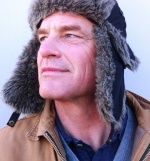
Arthur Joura- Member
 Re: American Bonsai at the NC Arboretum
Re: American Bonsai at the NC Arboretum
Nice to see you here, Arthur. I look forward to your continued participation! 

John Quinn- Member
 Re: American Bonsai at the NC Arboretum
Re: American Bonsai at the NC Arboretum
I have never been to your arboretum, but I have seen pictures of it and it's trees. It's a beautiful place. I have also seen a couple of your demos online and I really like your approach to bonsai design (especially with deciduous material). Welcome back to IBC.
I completely understand the notion of negative and hurtful speech that one may experience in this forum from time to time, but in my experience I don't fret over those folks too much because they end up making a fool of themselves.
I completely understand the notion of negative and hurtful speech that one may experience in this forum from time to time, but in my experience I don't fret over those folks too much because they end up making a fool of themselves.
Guest- Guest
 Re: American Bonsai at the NC Arboretum
Re: American Bonsai at the NC Arboretum
I love the Opus, Arthur! And, I read that you're promising even MORE videos, pictures and *gasp* even the occasional future commentary?!!!
 Wow!
Wow! 
The Jgeanangel post with the video he made of you styling the Persian Parrotia tree, was a CLINIC on how to properly work more developed, deciduous tree material. Great stuff!
Hope you stick around IBC, and even swim in the pool with us occasionally.
The Jgeanangel post with the video he made of you styling the Persian Parrotia tree, was a CLINIC on how to properly work more developed, deciduous tree material. Great stuff!
Hope you stick around IBC, and even swim in the pool with us occasionally.
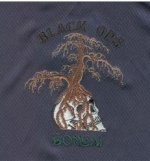
Auballagh- Member
 N. Carolina Arboretum
N. Carolina Arboretum
Thank you for your introduction. I have been to your web site & I know a little about the collection. http://www.ncarboretum.org/exhibits/outdoors-2/bonsai/
It contains work by Bill Valavanis, Yuji Yoshimura (of blessed memory), and I think a few other people I have known. I wish I could visit it. I think you could place more emphasis on the fact that the arboretum tries to present especially bonsai of native species. (Or it did when I looked.) I find that very inspiring.
Walter Pall's comment is indeed puzzling. Was it meant as a compliment or a criticism? Every active bonsai grower knows by now that bonsai is no longer "Japanese," just as opera is no longer Italian and stained glass windows are no longer German, etc.
Iris
It contains work by Bill Valavanis, Yuji Yoshimura (of blessed memory), and I think a few other people I have known. I wish I could visit it. I think you could place more emphasis on the fact that the arboretum tries to present especially bonsai of native species. (Or it did when I looked.) I find that very inspiring.
Walter Pall's comment is indeed puzzling. Was it meant as a compliment or a criticism? Every active bonsai grower knows by now that bonsai is no longer "Japanese," just as opera is no longer Italian and stained glass windows are no longer German, etc.
Iris
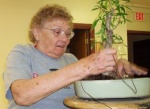
bonsaisr- Member
 Re: American Bonsai at the NC Arboretum
Re: American Bonsai at the NC Arboretum
Arthur,
Thanks for beginning this endeavor. I look forward to seeing updates from you and seeing and reading about what is happening at the Arboretum. Also, I hope to see you at the Spring Show next week.
Regards,
Martin
Thanks for beginning this endeavor. I look forward to seeing updates from you and seeing and reading about what is happening at the Arboretum. Also, I hope to see you at the Spring Show next week.
Regards,
Martin
MartinSweeney- Member
 Re: American Bonsai at the NC Arboretum
Re: American Bonsai at the NC Arboretum
Having seen Arthur's presentations at our club meeting for the past 3 years (that I've been a member because he's actually been coming here for 15 years I think) his presentations are among the best and always leave the club with plenty of inspiration and discussion.
His time is precious (he cares for many, many trees) and I for one (among many others I'm sure) truly appreciate it and look forward to learning more from him. And Iris, you're completely right; Arthur loves and fully advocates the use of native plants. The group plantings at the Arboretum are some of the finest I've seen in pictures or in person.
Welcome back Arthur!!!!
Sam
His time is precious (he cares for many, many trees) and I for one (among many others I'm sure) truly appreciate it and look forward to learning more from him. And Iris, you're completely right; Arthur loves and fully advocates the use of native plants. The group plantings at the Arboretum are some of the finest I've seen in pictures or in person.
Welcome back Arthur!!!!
Sam

Sam Ogranaja- Member
 Re: American Bonsai at the NC Arboretum
Re: American Bonsai at the NC Arboretum
Arthur Joura wrote:
Consider this - In 2011 the world famous bonsai artist Walter Pall made his second trip to our Arboretum and afterwards wrote a nice entry in his blog to tell his many readers all about it (http://walter-pall-travelogues.blogspot.com/2011/10/expo-2011-in-nc-bonsai-collection-in_8842.html). His review of our bonsai efforts included the following: “This collection is NOT aimed at the bonsai crowd but at the general innocent public... It makes no attempt to convey bonsai as a Japanese art form.”
What a curious statement! The second half of what he said is exactly right, but the first part baffles me. Although it is true that the great majority of people who visit our garden are members of the general public, which does not have much familiarity with the art of cultivating miniature trees and landscapes, it is my fond hope that bonsai as it is presented at the North Carolina Arboretum will indeed please people who already know and appreciate bonsai. In my more conceited moments, I actually dare to think the way we present bonsai might in some small way influence “the bonsai crowd”. I suppose this subject will be addressed in more detail by and by.
Curious statement? "nice entry"!
So how does this make sense? Well, it should be obvious from how much I published about the Arboretum in my blog that I have deep respect of what I saw there, and deep respect of what Arthur Joura has achieved. So my statements could not possible have been meant as critique but rather as an observation if not as a compliment.
Judging from Arthur being baffled about my words I assume that his intention is well to aim at the bonsai crowd. My statement was more about my observations there and not about Arthur's intentions. I did mention in my blog that the exhibit contains quite a lot of forest type objects. I don't remember having seen a major collection with so many forests. And the forests are all good and "nice"; "nice" meaning natural looking and not man-made. An observation that I have made in my bonsai life is that the innocent general public always easily associates with well done natural forest plantings and too often has problems appreciating mainstream powerful deadwood sculptures presented as "bonsai". The general public invariably awards "publics best of show" to the forest or the flowering apple tree. The renowned bonsai jury (at least in Europe) invariably awards the artificial deadwood monsters as "best bonsai". This is an observation and does not mean that either is good or bad.
Knowing this, one has to think about the appearance of a permanent public bonsai exhibit. One can aim at reaching the general public with what they associate easily or one can try to educate the general people and show them what is actually good by state of the art bonsai judging. Or one can try to do both, which is probably a good idea anyway. When taking another look at the pictures of the exhibit in my blog I again come to the concision that the show is clearly aimed at the general innocent bonsai public more than at the inside bonsai scene. Well, it better be. The inside bonsai scene in America only consists of three hundred or so folks. The majority of them will never make it to the Arboretum.
If one would want to aim at the bonsai crowd one would have to try to show what are the price winning trees at the major shows in the country. One would find that there are not too many of them and that most of them are not for sale. The aim would have to be to be as good or better than the major shows. This would be possible only with a real lot of money and lots of time. A million is not a real lot of money in this context.
So then with enormous effort and money you would have an exhibit in Asheville that matches state of the art mainstream bonsai shows and is even better. The inner bonsai circles consisting of a couple hundred people would applaud. So what? Well, probably they wold not even applaud anyway.
I couldn't see any attempt to aim at being the "best bonsai exhibit in the country" nor could I sense this from discussions with Arthur. I have to repeat myself now: Clearly the exhibit is aiming at the innocent general public and not at the bonsai crowd. I think it is fine as it is. Those who know what I personally stand for in the bonsai world will understand that I honestly think that this is "fine as it is".
"...bonsai as it is presented at the North Carolina Arboretum will indeed please people who already know and appreciate bonsai. In my more conceited moments, I actually dare to think the way we present bonsai might in some small way influence “the bonsai crowd”. I suppose this subject will be addressed in more detail by and by. " Good aim! I wonder how it will work. Anyways it is my sincere wish that it will work eventually.

Walter Pall- Member
 Re: American Bonsai at the NC Arboretum
Re: American Bonsai at the NC Arboretum
One day I would love to visit the arboretum and enjoy the exhibits, I understand Walters 'take' on the approach and applaud his honestly.
Many years ago I visited the 'National bonsai collection of Scotland' and was sorely dissapointed as many of the trees were dreadful, unkempt and should never have been on display. However the general public were 'enthralled' and delighted at what they saw... So who was I to condemn what I was on display... My only concern being that it perpetuated the 'Tree in pot therefore it's a bonsai' belief.
Many years ago I visited the 'National bonsai collection of Scotland' and was sorely dissapointed as many of the trees were dreadful, unkempt and should never have been on display. However the general public were 'enthralled' and delighted at what they saw... So who was I to condemn what I was on display... My only concern being that it perpetuated the 'Tree in pot therefore it's a bonsai' belief.
Guest- Guest
 Re: American Bonsai at the NC Arboretum
Re: American Bonsai at the NC Arboretum
Tony,
if one looks at the photographs that i made of the exhibit it is clear that there are NOT unkempt sticks in pots but very good trees. I only wanted to say that these bonsai are not of the type that are of the mainstream taste of fat, impressive plastic bonsai with endless deadwood.
if one looks at the photographs that i made of the exhibit it is clear that there are NOT unkempt sticks in pots but very good trees. I only wanted to say that these bonsai are not of the type that are of the mainstream taste of fat, impressive plastic bonsai with endless deadwood.

Walter Pall- Member
 Re: American Bonsai at the NC Arboretum
Re: American Bonsai at the NC Arboretum
I think we are seeing a difference in regional/national styles. To me the European trees look complicated. I don't know how else to put it.
But, I live in Florida and the trees I prefer are the Ficus, which require a different style than the pines, maples, etc. that the people further north or in Europe work with.
But, I live in Florida and the trees I prefer are the Ficus, which require a different style than the pines, maples, etc. that the people further north or in Europe work with.

Billy M. Rhodes- Member
 Re: American Bonsai at the NC Arboretum
Re: American Bonsai at the NC Arboretum
Billy,
Far be it from me to speak for Arthur, but you are correct. The Staples Collection at the North Carolina Arboretum is achieving a sense of place, that being the southern Appalachian Mountains in western North Carolina.
Regards,
Martin
Far be it from me to speak for Arthur, but you are correct. The Staples Collection at the North Carolina Arboretum is achieving a sense of place, that being the southern Appalachian Mountains in western North Carolina.
Regards,
Martin
MartinSweeney- Member
 Re: American Bonsai at the NC Arboretum
Re: American Bonsai at the NC Arboretum
I've made it a point to take pics of the Trees at the NC Arboretum. For anyone that cares to see the quality of the collection, here are a few links.
http://bonsaistudygroup.com/bonsai-shows-competitions-and-displays/north-carolina-arboretum%27s-bonsai-collection/
http://upstatebonsai.com/glr/v/bwaynef/NCArb/
The links below should give an indication of what is encouraged at the show. There are also pictures from the Arboretum's collections throughout.
http://bonsaistudygroup.com/bonsai-shows-competitions-and-displays/carolina-bonsai-expo-2009/
http://bonsaistudygroup.com/bonsai-shows-competitions-and-displays/carolina-bonsai-expo-2010-pictures/
http://bonsaistudygroup.com/bonsai-shows-competitions-and-displays/carolina-bonsai-expo-2011/
(I didn't make it to the 2012 show for sundry reasons.)
http://bonsaistudygroup.com/bonsai-shows-competitions-and-displays/north-carolina-arboretum%27s-bonsai-collection/
http://upstatebonsai.com/glr/v/bwaynef/NCArb/
The links below should give an indication of what is encouraged at the show. There are also pictures from the Arboretum's collections throughout.
http://bonsaistudygroup.com/bonsai-shows-competitions-and-displays/carolina-bonsai-expo-2009/
http://bonsaistudygroup.com/bonsai-shows-competitions-and-displays/carolina-bonsai-expo-2010-pictures/
http://bonsaistudygroup.com/bonsai-shows-competitions-and-displays/carolina-bonsai-expo-2011/
(I didn't make it to the 2012 show for sundry reasons.)
bwaynef- Member
 Re: American Bonsai at the NC Arboretum
Re: American Bonsai at the NC Arboretum
And we've had threads here on the IBC displaying the Arb's trees and after each of the last several Expos. A search will turn those up.
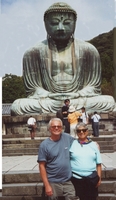
JimLewis- Member
 Tamarack
Tamarack
Thank you to those who posted their supportive comments! Thank you, too, to Walter Pall for clarifying his statement. As usual, he has a wider field of view and a more insightful mind than most.
As I am writing this we are only in the last part of February, but it seems spring is right around the corner. Spring has been showing up earlier in this part of the world in recent years, just as summer has become longer and hotter and winter generally shorter and milder. From a practical standpoint in bonsai it means having less time to do off-season work in preparation of the growing season, in addition to the concern that plants might initiate growth and then be subject to an abrupt turnaround in temperature, as winter returns in… well, what is technically still winter.
In light of this, I have been busy of late taking care of necessary work in advance of the plants coming out of dormancy. The tasks are the usual – pruning, wiring and repotting. Today I did the first two items on that list for this specimen, a Tamarack (Larix laricina):
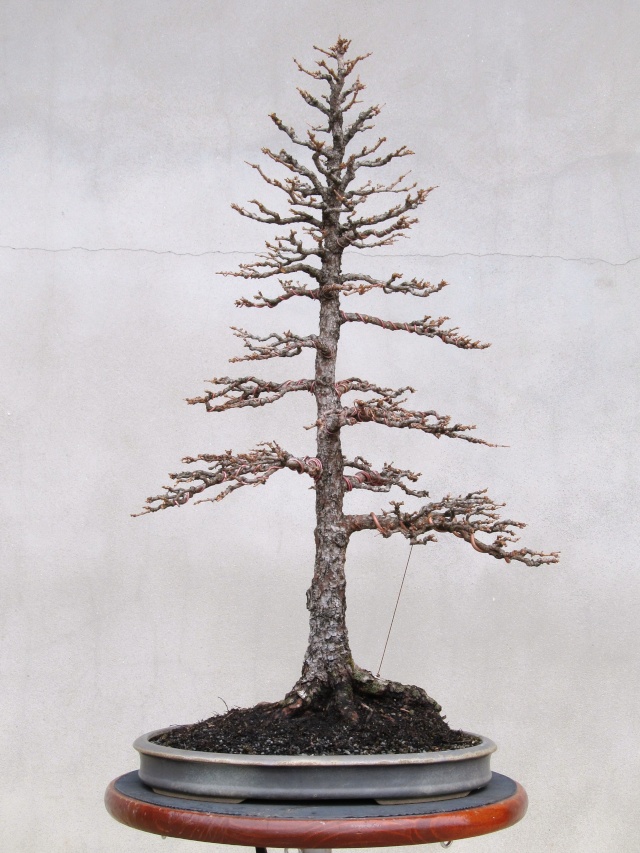
This tree is unique in our collection for a couple of reasons; it is the only true formal upright we have (we have one large Procumbens Juniper that pretends to be formal upright but really is not), and it is the only Tamarack we have.
Tamarack, or American Larch, might be thought of as a native tree by some, but it is not native to where we are. They occur naturally in the very northernmost Northeastern and Central United States on up into vast stretches of Canada, where their range extends westward on up into Alaska. Obviously, this is a species that is adapted for colder climates. Asheville, due to the influence of our elevation, might be as far south as Tamarack can grow without special assistive measures. That may well change in the years ahead.
This specimen is also unique for being one of only a few older bonsai in the Arboretum’s collection for which we have reliable information pertaining to its history and age. This tree was collected as 1-year seedling in Michigan in 1974 by a local woman named Dorothy Wells, which makes it approximately 40 years of age. In all, Ms. Wells collected 4 such seedlings and brought them home to Asheville, where she planted 3 of them in her home landscape and made 1 into a bonsai. The 3 she put in the ground still live and they are now 25 to 30 feet tall and about 1 foot in diameter a few feet above ground level. This bonsai stands 30 inches tall and 2 inches in diameter, measured a couple of inches above the base.
The first time I saw this tree was at a show put on by the local Blue Ridge Bonsai Society in 1992, and it looked like this:

Ms. Wells donated the tree to the Arboretum in 1995, at which point it looked like this:

The next year I began working on the design of the tree, removing the lowest branch on the left, straightening the upper trunk and attempting to bring down the first branch on the right (I have come to find Tamarack, or at least this specimen, difficult to train, in that it has a short memory once wiring is removed. I am still trying to train that branch to descend):
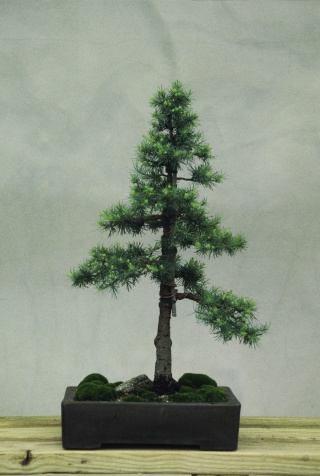
This bonsai, like all others, has its faults. I find it easy to forgive them, however, when it is in its autumn colors:

As I am writing this we are only in the last part of February, but it seems spring is right around the corner. Spring has been showing up earlier in this part of the world in recent years, just as summer has become longer and hotter and winter generally shorter and milder. From a practical standpoint in bonsai it means having less time to do off-season work in preparation of the growing season, in addition to the concern that plants might initiate growth and then be subject to an abrupt turnaround in temperature, as winter returns in… well, what is technically still winter.
In light of this, I have been busy of late taking care of necessary work in advance of the plants coming out of dormancy. The tasks are the usual – pruning, wiring and repotting. Today I did the first two items on that list for this specimen, a Tamarack (Larix laricina):

This tree is unique in our collection for a couple of reasons; it is the only true formal upright we have (we have one large Procumbens Juniper that pretends to be formal upright but really is not), and it is the only Tamarack we have.
Tamarack, or American Larch, might be thought of as a native tree by some, but it is not native to where we are. They occur naturally in the very northernmost Northeastern and Central United States on up into vast stretches of Canada, where their range extends westward on up into Alaska. Obviously, this is a species that is adapted for colder climates. Asheville, due to the influence of our elevation, might be as far south as Tamarack can grow without special assistive measures. That may well change in the years ahead.
This specimen is also unique for being one of only a few older bonsai in the Arboretum’s collection for which we have reliable information pertaining to its history and age. This tree was collected as 1-year seedling in Michigan in 1974 by a local woman named Dorothy Wells, which makes it approximately 40 years of age. In all, Ms. Wells collected 4 such seedlings and brought them home to Asheville, where she planted 3 of them in her home landscape and made 1 into a bonsai. The 3 she put in the ground still live and they are now 25 to 30 feet tall and about 1 foot in diameter a few feet above ground level. This bonsai stands 30 inches tall and 2 inches in diameter, measured a couple of inches above the base.
The first time I saw this tree was at a show put on by the local Blue Ridge Bonsai Society in 1992, and it looked like this:

Ms. Wells donated the tree to the Arboretum in 1995, at which point it looked like this:

The next year I began working on the design of the tree, removing the lowest branch on the left, straightening the upper trunk and attempting to bring down the first branch on the right (I have come to find Tamarack, or at least this specimen, difficult to train, in that it has a short memory once wiring is removed. I am still trying to train that branch to descend):

This bonsai, like all others, has its faults. I find it easy to forgive them, however, when it is in its autumn colors:


Arthur Joura- Member
 Re: American Bonsai at the NC Arboretum
Re: American Bonsai at the NC Arboretum
Awesome tree and glad to see you posting here, looking forward to more posts. I visited the Arboretum for the show last fall and am looking forward to my next visit. Cheers AJ.
hometeamrocker- Member
 Re: American Bonsai at the NC Arboretum
Re: American Bonsai at the NC Arboretum
JimLewis wrote:And we've had threads here on the IBC displaying the Arb's trees and after each of the last several Expos. A search will turn those up.
I bothered to search for and post the threads with which I'm most familiar. The links I've posted detail to some extent the Carolina Bonsai Expo & the NC Arboretum's collection from 2005 - 2011. Feel free to remove any of my links you feel are inappropriate.
Arthur, I was by the NC Arb. 2 Fridays ago to see what you had on display. Sadly, I came after the greenhouse had closed so I only got to see the few that were out in the bonsai pavilion. Regardless, they made an impact on friends/neighbors I was travelling with who'd never seen higher-quality bonsai. The beauty of the surroundings were worth the trouble anyway. (And now, I've an excuse to get back to see the collection.)
That larch is one of my favorites if only for its simplicity. (Not that I believe it'd be simple to create or maintain such a tree, ...but that it doesn't try to be more than it is.)
bwaynef- Member
 Re: American Bonsai at the NC Arboretum
Re: American Bonsai at the NC Arboretum
Arthur
I was inspired by your presentation at the Susquehanna Bonsai Club on tray landscapes recently. Thank you very much. I’m now looking more closely at the tiny Beech trees that grow in my neighborhood, which I previously considered useless. I love your concept (maybe not yours, but presented by you) of a regional style of bonsai, yours being the Appalachian style. Again, thanks.
I was inspired by your presentation at the Susquehanna Bonsai Club on tray landscapes recently. Thank you very much. I’m now looking more closely at the tiny Beech trees that grow in my neighborhood, which I previously considered useless. I love your concept (maybe not yours, but presented by you) of a regional style of bonsai, yours being the Appalachian style. Again, thanks.
Dave Leppo- Member
 Re: American Bonsai at the NC Arboretum
Re: American Bonsai at the NC Arboretum
This last Thursday I spent the day repotting, and among the trees addressed that day was the Tamarack.
The handsome blue/gray container for this plant was made by the late American potter, Don Gould. He was from eastern Pennsylvania, and one of the distinguishing features of his pots was a centrally located, keystone shaped drain hole:

Here is a look at his signature and chop, on the bottom of the container:
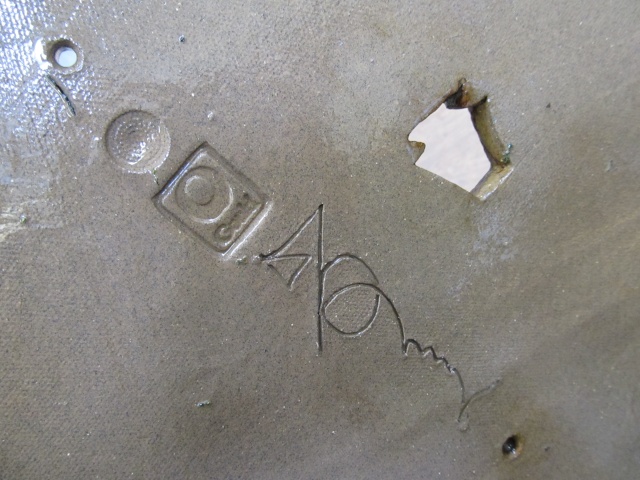
One of the weak points of this Tamarack is its base, with the elongated root sticking out horizontally from the right side as one looks at the tree from the front. When the tree was donated to us, it came with a rock planted at its base on the opposite side from the offending root, in an attempt to create a counterbalance. I left that stone in place through many repottings, but ultimately decided it did not really help matters and finally removed it. It has been my observation over the years that a bonsai with a rock or rocks around its base has usually got something to hide.

This year I decided to try something I have been considering for awhile - shifting the tree to the left of center in the container. Deciding the visual movement of a formal upright tree can sometimes be a coin toss, as is the case with this Tamarack, I think. One benefit I hoped to derive from the move was a more favorable positioning of the problem root, allowing it more room as opposed to being hard against the right hand side of the container. I am not certain that worked, but I like the look of the tree positioned as it is now, anyway:

In response to a comment left by bwaynef - I agree this specimen has an agreeable sort of simplicity in feeling. Formal upright may be the elemental bonsai form (as I recall reading somewhere), but it is not inherently dynamic. That this particular one does not feature any deadwood also lends it a more subdued and humble character. "Power Bonsai" it is not.
Hometeamrocker, thanks for your response and for visiting last year's Expo!
Dave Leppo, I greatly enjoyed my visit to Harrisburg, as I always do. The bonsai folks who live in that area are so fortunate to have Jim and Mary Kay Doyle, and Nature's Way Nursery, as ready resources. I am glad you found the Tray Landscape program to be of use; I think that form of bonsai is accessible and enjoyable for people at all skill levels. It allows for creative use of even very young plant material, such as the 3-year old American Hornbeam seedlings I used for the demonstration. Here is a photograph I made of that planting once I returned home, to document its earliest stage of existence:

I look forward to watching this in time become a beautiful, naturalistic woodland scene.
The handsome blue/gray container for this plant was made by the late American potter, Don Gould. He was from eastern Pennsylvania, and one of the distinguishing features of his pots was a centrally located, keystone shaped drain hole:

Here is a look at his signature and chop, on the bottom of the container:

One of the weak points of this Tamarack is its base, with the elongated root sticking out horizontally from the right side as one looks at the tree from the front. When the tree was donated to us, it came with a rock planted at its base on the opposite side from the offending root, in an attempt to create a counterbalance. I left that stone in place through many repottings, but ultimately decided it did not really help matters and finally removed it. It has been my observation over the years that a bonsai with a rock or rocks around its base has usually got something to hide.

This year I decided to try something I have been considering for awhile - shifting the tree to the left of center in the container. Deciding the visual movement of a formal upright tree can sometimes be a coin toss, as is the case with this Tamarack, I think. One benefit I hoped to derive from the move was a more favorable positioning of the problem root, allowing it more room as opposed to being hard against the right hand side of the container. I am not certain that worked, but I like the look of the tree positioned as it is now, anyway:

In response to a comment left by bwaynef - I agree this specimen has an agreeable sort of simplicity in feeling. Formal upright may be the elemental bonsai form (as I recall reading somewhere), but it is not inherently dynamic. That this particular one does not feature any deadwood also lends it a more subdued and humble character. "Power Bonsai" it is not.
Hometeamrocker, thanks for your response and for visiting last year's Expo!
Dave Leppo, I greatly enjoyed my visit to Harrisburg, as I always do. The bonsai folks who live in that area are so fortunate to have Jim and Mary Kay Doyle, and Nature's Way Nursery, as ready resources. I am glad you found the Tray Landscape program to be of use; I think that form of bonsai is accessible and enjoyable for people at all skill levels. It allows for creative use of even very young plant material, such as the 3-year old American Hornbeam seedlings I used for the demonstration. Here is a photograph I made of that planting once I returned home, to document its earliest stage of existence:

I look forward to watching this in time become a beautiful, naturalistic woodland scene.

Arthur Joura- Member
 Experiment in Display
Experiment in Display
There is an idea expressed often enough in this forum, usually phrased something like this: “The picture does not do it justice, this looks better in person.” It might be tempting to think the person saying this is making excuses, and perhaps sometimes they are, but most of us know there are some subjects and situations where the image comes up short of reality. Sometimes this may be due to the person making the picture not being particularly adept at photography, but on many other occasions the shortfall is due to the camera lens not being as sensitive as the human eye.
For example, in the Bonsai Exhibition Garden almost all of our specimens on display are presented in front of a textured, gray wall, which makes it easy to see the bonsai without any background clutter. This arrangement makes it easy to photograph the trees:

There are 2 display benches, however, that are free-standing – without any wall behind them. If you are in the garden looking at the specimens displayed on these benches, you will be able to see them without great difficulty, although in some instances the scenery behind the trees may be distracting. Our eyes have the ability to make an adjustment and “read” the subject matter off the background. This happens more or less automatically, without our being conscious of it. But when we make a photograph of the specimen displayed this way, the camera lens records what is in front of it, without discerning what is intended as subject as compared to background. Many of these types of photographs are the ones shown with the caveat, “it looked better than that in person.”
Here is a photograph of a Baldcypress (Taxodium distichum) tray landscape illustrating that effect:

Here is the same subject taken at a time when the sun, being low in the sky, backlights the bonsai and makes it easy to read off of the background:
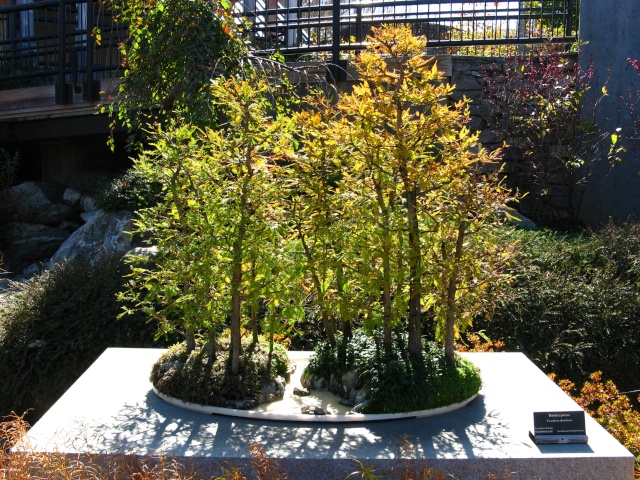
So, we can see the benefits of advantageous lighting, at least as far as for making a decent photographic image.
All this is nothing more than a lead-up to showing an image I have been debating about posting. The subject matter of this image will be unwelcome enough for many people, just because of what it is, but to make matters worse, the image is not a very good representation.
A couple of weeks ago I presented a tree as part of a larger bonsai display at the Southern Home & Garden Spring Show in Charlotte, NC. The overall display is organized by the Bonsai Society of the Carolinas, and each presenter is given an alcove in which to set up their own display. The alcove space is approximately 4 feet wide, deep and high. There are 9 alcoves in total, and mostly the people presenting trees do so in what might be thought of as the “traditional” method. That is to say, they attempt to follow the norms of Japanese style tokonoma display, with the tree on a stand, in front of a scroll and accompanied by an accent item, all usually Asian-themed. There are good trees on display, and most of the Asian-themed accessories are pleasantly arranged. The public enjoys the show.
The Arboretum has participated in this event for at least the past 15 years. The main purpose for doing so is to support our friends in the BSC, as well as to publicize the Arboretum to the many thousands of people who visit the Southern Spring Home & Garden show. On a personal level, I enjoy having the opportunity to design a bonsai display other than the ongoing display featured in our bonsai garden.
How bonsai are presented has great effect on how they are viewed. I am interested in finding new and different ways to display bonsai in a formal setting, as I think this is an avenue of great potential for creative expression and broadening the way in which we think of bonsai as an art form.
Last year at the 3rd US National Bonsai Exhibition in Rochester, NY, the NC Arboretum display looked like this:

The strongly horizontal painted image featured in this display represents clouds in the sky at sunset, although they are rendered in a fairly abstract way. I felt satisfied with the overall effect of this presentation and received enough encouraging feedback to think it a successful effort.
For this recent show in Charlotte, I decided to go further in the direction of using an abstract image as a backdrop for bonsai display. My idea was to move beyond the theme of an image from nature (the sky at sunset, for example) and work with an image that consisted only of shape and color. Because the bonsai to be displayed was a tropical species, Willow-leaf Fig (Ficus neriifolia), and possibly also because I wanted to make a display that broke out of the winter doldrums, I decided to use bright, bold colors applied in a literally splashy way. I knew this presentation would not appeal to every taste, but nothing ever does. The important thing was to try a new idea and see how it worked.
First, some context; here is a look at the overall display being enjoyed by the visiting public:

This sidelong view of the Arboretum display gives a sense of the effect of the combination of bright colors and tropical tree:

And here is a frontal view of the display itself:

As I started out saying in this post, there are some situations where a photograph does not do justice to the subject being presented. I am disappointed with the quality of this image, because it does not give an accurate sense of how the display looked in person. Lighting was the main problem in this instance, as the back of the alcove where the painting was hung received more light than the bonsai in the foreground. This was true in person, too, but is more pronounced in the photograph. In person it was easier for the viewer to read the bonsai off of the background. The background was certainly visible and had real effect on the image of the tree, but did not overpower it to quite the extent it does in the picture. It was too strong, however, even for what I wanted to achieve. If I was doing it over I would tone down the colors a bit.
Here is a picture of the Fig by itself, with a plain backdrop:

Here is a picture of the display alcove without the tree:

The inventor Thomas Edison was once questioned on his repeated failures to find just the right material to use as the filament in the first electric light. Edison replied that he had not failed, but had instead successfully identified 10,000 materials that did not work.
Live and learn.
For example, in the Bonsai Exhibition Garden almost all of our specimens on display are presented in front of a textured, gray wall, which makes it easy to see the bonsai without any background clutter. This arrangement makes it easy to photograph the trees:

There are 2 display benches, however, that are free-standing – without any wall behind them. If you are in the garden looking at the specimens displayed on these benches, you will be able to see them without great difficulty, although in some instances the scenery behind the trees may be distracting. Our eyes have the ability to make an adjustment and “read” the subject matter off the background. This happens more or less automatically, without our being conscious of it. But when we make a photograph of the specimen displayed this way, the camera lens records what is in front of it, without discerning what is intended as subject as compared to background. Many of these types of photographs are the ones shown with the caveat, “it looked better than that in person.”
Here is a photograph of a Baldcypress (Taxodium distichum) tray landscape illustrating that effect:

Here is the same subject taken at a time when the sun, being low in the sky, backlights the bonsai and makes it easy to read off of the background:

So, we can see the benefits of advantageous lighting, at least as far as for making a decent photographic image.
All this is nothing more than a lead-up to showing an image I have been debating about posting. The subject matter of this image will be unwelcome enough for many people, just because of what it is, but to make matters worse, the image is not a very good representation.
A couple of weeks ago I presented a tree as part of a larger bonsai display at the Southern Home & Garden Spring Show in Charlotte, NC. The overall display is organized by the Bonsai Society of the Carolinas, and each presenter is given an alcove in which to set up their own display. The alcove space is approximately 4 feet wide, deep and high. There are 9 alcoves in total, and mostly the people presenting trees do so in what might be thought of as the “traditional” method. That is to say, they attempt to follow the norms of Japanese style tokonoma display, with the tree on a stand, in front of a scroll and accompanied by an accent item, all usually Asian-themed. There are good trees on display, and most of the Asian-themed accessories are pleasantly arranged. The public enjoys the show.
The Arboretum has participated in this event for at least the past 15 years. The main purpose for doing so is to support our friends in the BSC, as well as to publicize the Arboretum to the many thousands of people who visit the Southern Spring Home & Garden show. On a personal level, I enjoy having the opportunity to design a bonsai display other than the ongoing display featured in our bonsai garden.
How bonsai are presented has great effect on how they are viewed. I am interested in finding new and different ways to display bonsai in a formal setting, as I think this is an avenue of great potential for creative expression and broadening the way in which we think of bonsai as an art form.
Last year at the 3rd US National Bonsai Exhibition in Rochester, NY, the NC Arboretum display looked like this:

The strongly horizontal painted image featured in this display represents clouds in the sky at sunset, although they are rendered in a fairly abstract way. I felt satisfied with the overall effect of this presentation and received enough encouraging feedback to think it a successful effort.
For this recent show in Charlotte, I decided to go further in the direction of using an abstract image as a backdrop for bonsai display. My idea was to move beyond the theme of an image from nature (the sky at sunset, for example) and work with an image that consisted only of shape and color. Because the bonsai to be displayed was a tropical species, Willow-leaf Fig (Ficus neriifolia), and possibly also because I wanted to make a display that broke out of the winter doldrums, I decided to use bright, bold colors applied in a literally splashy way. I knew this presentation would not appeal to every taste, but nothing ever does. The important thing was to try a new idea and see how it worked.
First, some context; here is a look at the overall display being enjoyed by the visiting public:

This sidelong view of the Arboretum display gives a sense of the effect of the combination of bright colors and tropical tree:

And here is a frontal view of the display itself:

As I started out saying in this post, there are some situations where a photograph does not do justice to the subject being presented. I am disappointed with the quality of this image, because it does not give an accurate sense of how the display looked in person. Lighting was the main problem in this instance, as the back of the alcove where the painting was hung received more light than the bonsai in the foreground. This was true in person, too, but is more pronounced in the photograph. In person it was easier for the viewer to read the bonsai off of the background. The background was certainly visible and had real effect on the image of the tree, but did not overpower it to quite the extent it does in the picture. It was too strong, however, even for what I wanted to achieve. If I was doing it over I would tone down the colors a bit.
Here is a picture of the Fig by itself, with a plain backdrop:

Here is a picture of the display alcove without the tree:

The inventor Thomas Edison was once questioned on his repeated failures to find just the right material to use as the filament in the first electric light. Edison replied that he had not failed, but had instead successfully identified 10,000 materials that did not work.
Live and learn.
Last edited by Arthur Joura on Thu Mar 28, 2013 4:02 pm; edited 1 time in total

Arthur Joura- Member
 Chestnut Oak
Chestnut Oak
Last week I took an afternoon off and went for a hike with my son in the mountains not far from my house. Winter is drawing to a close and I wanted to take the opportunity to go and look one more time at the winter landscape. Although I will be glad to see the return of spring green, it is so instructive to study the structure of mature deciduous trees shaped by life on the mountain ridges, when they are bare of leaves. Their forms are inspirational to me, and inform my ideas about bonsai design.
I made many photographs, as usual. These two trees, both Chestnut Oaks (Quercus prinus), caught my eye:

I thought this branch in particular offered an interesting idea for bonsai branch shaping:

Chestnut Oak, sometimes called Rock Oak, is a common species in the eastern United States, often found growing in rocky areas or on dry ridges. I have seen them growing in favorable locations as well, and there they will grow straight and tall. But when they grow in poorer sites they often assume gnarly and sometimes strange shapes:

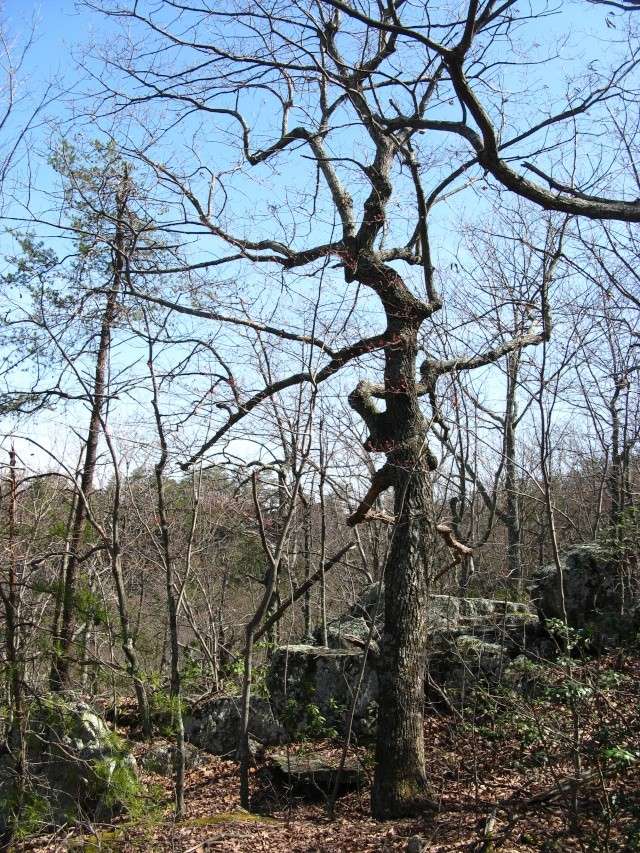


The image of a Chestnut Oak growing on a rocky, dry ridge was the inspiration for this tray landscape:

The main tree is a Chinese Quince (Pseudocydonia sinensis), and the photograph is from last October. I need to repot this specimen now and I hope to post more about it in the days ahead.
I made many photographs, as usual. These two trees, both Chestnut Oaks (Quercus prinus), caught my eye:

I thought this branch in particular offered an interesting idea for bonsai branch shaping:

Chestnut Oak, sometimes called Rock Oak, is a common species in the eastern United States, often found growing in rocky areas or on dry ridges. I have seen them growing in favorable locations as well, and there they will grow straight and tall. But when they grow in poorer sites they often assume gnarly and sometimes strange shapes:




The image of a Chestnut Oak growing on a rocky, dry ridge was the inspiration for this tray landscape:

The main tree is a Chinese Quince (Pseudocydonia sinensis), and the photograph is from last October. I need to repot this specimen now and I hope to post more about it in the days ahead.
Last edited by Arthur Joura on Thu Mar 28, 2013 4:01 pm; edited 1 time in total

Arthur Joura- Member
 Chinese Quince
Chinese Quince
The repotting of this landscape planting was done last Thursday. Prior to that the primary tree, Chinese Quince (Pseudocydonia sinensis), and understory shrubs, an unknown variety of spirea (Spiraea sp.) I brought home from Japan many years ago, were completely pruned. Now the planting is ready for the new growing season, and not a moment too soon:

Here is a look at the ground plane in its current configuration:

There had previously been 3 stones, but one has been removed. The large mass of non-moss ground cover, visible on the right hand side of the planting in the previously posted photograph from last autumn, is Creeping Thyme (Thymus praecox). It has been broken into several smaller pieces for the replanting, with the understanding that in the course of the growing season it will once again multiply and spread itself out.
The Chinese Quince in this planting was given to the Arboretum in 1995 by the late Felton Jones. At that time it was one of many 1-year seedlings growing in a gang pot, and I took them apart and potted them individually shortly after they arrived. As a frame of reference, this is what a 1-year Chinese Quince seedling looks like (this is not the same individual that became the focal point in the landscape planting in question, but most 1-year quince seedlings look pretty much the same):

Over the years I used many of the other seedlings for workshops and demonstrations, but I kept one and planted it in the ground for a period of 4 or 5 years to build up a significant trunk. When it was eventually dug up, I took it to Columbia, SC for a demonstration at a meeting of the Bonsai Club of South Carolina. Here are a couple of impossibly grainy images showing the tree before and after the work done that day:


You might think, judging by the look of the photographs, this demonstration took place in the 1970's but it was actually done in spring of 2001. These images are photographs taken of pictures printed in an old black & white club newsletter; the originals were lost.
This planting served as the logo tree for the 2012 Carolina Bonsai Expo:
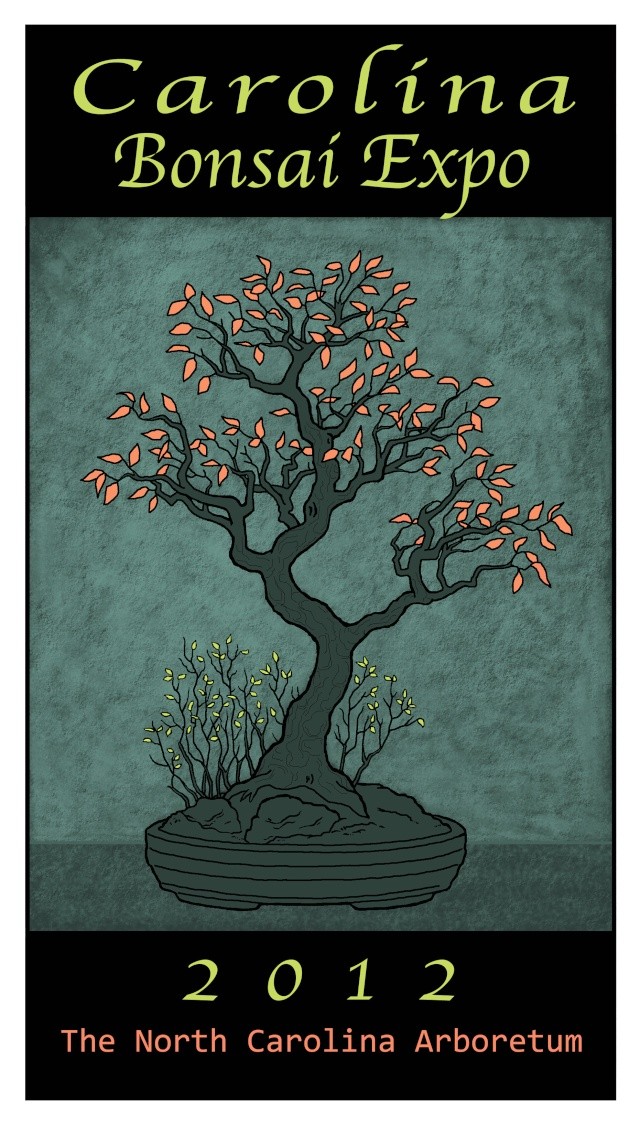

Here is a look at the ground plane in its current configuration:

There had previously been 3 stones, but one has been removed. The large mass of non-moss ground cover, visible on the right hand side of the planting in the previously posted photograph from last autumn, is Creeping Thyme (Thymus praecox). It has been broken into several smaller pieces for the replanting, with the understanding that in the course of the growing season it will once again multiply and spread itself out.
The Chinese Quince in this planting was given to the Arboretum in 1995 by the late Felton Jones. At that time it was one of many 1-year seedlings growing in a gang pot, and I took them apart and potted them individually shortly after they arrived. As a frame of reference, this is what a 1-year Chinese Quince seedling looks like (this is not the same individual that became the focal point in the landscape planting in question, but most 1-year quince seedlings look pretty much the same):

Over the years I used many of the other seedlings for workshops and demonstrations, but I kept one and planted it in the ground for a period of 4 or 5 years to build up a significant trunk. When it was eventually dug up, I took it to Columbia, SC for a demonstration at a meeting of the Bonsai Club of South Carolina. Here are a couple of impossibly grainy images showing the tree before and after the work done that day:


You might think, judging by the look of the photographs, this demonstration took place in the 1970's but it was actually done in spring of 2001. These images are photographs taken of pictures printed in an old black & white club newsletter; the originals were lost.
This planting served as the logo tree for the 2012 Carolina Bonsai Expo:


Arthur Joura- Member
 Re: American Bonsai at the NC Arboretum
Re: American Bonsai at the NC Arboretum
Thank you Arthur for retuning to IBC, these are great reads and inspirational threads...keep them coming.
Cheers from the great white north's...."wet coast".
Graham
Cheers from the great white north's...."wet coast".
Graham
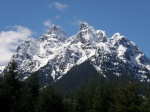
gman- Member
 Re: American Bonsai at the NC Arboretum
Re: American Bonsai at the NC Arboretum
Arthur Joura wrote:The repotting of this landscape planting was done last Thursday. Prior to that the primary tree, Chinese Quince (Pseudocydonia sinensis), and understory shrubs, an unknown variety of spirea (Spiraea sp.) I brought home from Japan many years ago, were completely pruned. Now the planting is ready for the new growing season, and not a moment too soon:
...
Very nice work! I like your attention to detail.
Best,
Dorothy

dorothy7774- Member
Page 1 of 40 • 1, 2, 3 ... 20 ... 40 
 Similar topics
Similar topics» American Bonsai at the NC Arboretum
» WISTERIA BONSAI AT INTERNATIONAL BONSAI ARBORETUM
» Ashville arboretum bonsai
» Autumn at the NC Arboretum bonsai garden
» How did the Buttonwood bonsai die at the National Arboretum?
» WISTERIA BONSAI AT INTERNATIONAL BONSAI ARBORETUM
» Ashville arboretum bonsai
» Autumn at the NC Arboretum bonsai garden
» How did the Buttonwood bonsai die at the National Arboretum?
Page 1 of 40
Permissions in this forum:
You cannot reply to topics in this forum|
|
|







